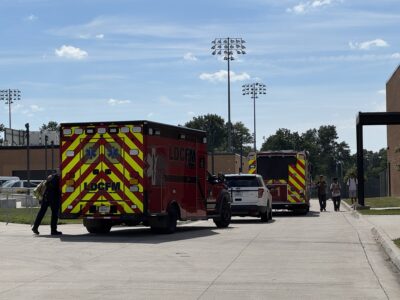Douglas County leaders express interest in not just maintaining Fire Medical service levels, but also adding a new ambulance

photo by: Josie Heimsoth/Journal-World
Douglas County commissioners met for the third day of budget hearings for the 2026 budget on Wednesday, July 9, 2025.
In anticipation of city-imposed cuts to Lawrence-Douglas County Fire Medical, county commissioners are expressing interest in not just spending extra to maintain some emergency service levels, but to staff a new ambulance, as well.
One of the topics discussed at the Douglas County Commission’s 2026 budget hearings on Wednesday was county staff’s proposal to include about $183,000 of extra funding for LDCFM, which the City of Lawrence has targeted for $1.5 million in budget cuts. The county’s proposal to make up some of that lost funding would allow LDCFM to keep many of its service levels steady, including maintaining seven 24-hour ambulances.
But the commission on Wednesday had questions about a more expensive option, which would require about $528,000 in new funding instead of $183,000 and would not only maintain ambulance service levels but also add a new ambulance that would operate 40 hours a week.
Commissioner Gene Dorsey said having an additional ambulance would be helpful for emergency personnel responding to events at David Booth Kansas Memorial Stadium at the University of Kansas, which is expected to reopen soon after a major renovation project that will also include a new conference center. And Tyler Wade, acting deputy fire chief of LDCFM, said a new ambulance could give the department flexibility in other ways, as well.
“[I]t could be used in a variety of ways and the timeframe that it could be on duty, we would look internally in our data to see our busiest times throughout a 24-hour period and try to work a schedule to accommodate those increases in call volume,” Wade said.
If county commissioners decide to move forward with such a plan, it won’t require them to actually purchase a new vehicle; LDCFM has some reserve ambulances that it would be able to put into operation, LDCFM chief of staff McKenzi Ezell said. Instead, the additional costs would relate to staffing and otherwise operating the ambulance. The department would need three full-time equivalent employees to operate it 40 hours a week.
Staffing has been a major concern in the discussions about LDCFM’s funding this year. The department, which is funded jointly by the city and county, previously said that it would have to cut 18 full-time-equivalent positions if the county provided no extra money this year.
With that would have come reductions in services: LDCFM would have had to reduce its number of battalion chiefs from six to three, eliminate its prevention lieutenant and training lieutenant positions and reduce its ambulance service capacity, converting one of its ambulances from 24/7 to 40 hours a week.
The proposal in the county’s 2026 budget that would cost about $183,000 would still require 10 positions to be cut. All of those positions are vacant, so no employees would be laid off. And that plan would also keep all current ambulances as 24/7 trucks and keep all six of the battalion chiefs.
New fire station’s costs
The commission and staff also discussed the City of Lawrence’s plans for a new fire station, and County Administrator Sarah Plinsky said that this project would add new costs for the county in a couple of years — and might require a tax hike.
The city’s Capital Improvement Plan lists $1.5 million for the new fire station, known as “Station 6,” in 2026, then about $5.4 million and $5.7 million in 2027 and 2028. But those figures are just for the new station’s construction; they don’t include what it would cost to staff it.
At Tuesday’s Lawrence City Commission meeting on the city’s budget proposal, acting LDCFM Chief Joe Hardy said there was a need for future discussions with the city and Douglas County about how to pay for that staffing. And on Wednesday, Plinsky said she already had some idea of what it might cost.
Plinsky estimated that the county’s annual operating cost for the station would be about $2 million, and that funding would need to begin in 2027. She said that could require the county to raise its property tax rate by one mill. One mill is one dollar per $1,000 of a property’s assessed value.
“I can’t guarantee in 2027 that we will have $2 million available under an existing mill levy to pay for that expansion,” Plinsky said. “The City of Lawrence has been very upfront that it would require them to raise taxes. In my view, I think the same could be said of us.”
Plinsky said the discussion about the additional ambulance was a good way to start thinking about expanding with a new station. But she also emphasized that there was a lot to be decided yet. When Commissioner Shannon Reid asked whether some extra funds could be allocated in 2026 to offset the increase anticipated for 2027, Plinsky said she was reluctant to do so because the city had not committed to adding staff to the station.
Later in the day, at the County Commission’s regular business meeting, Seamus Albritton, president of the local firefighters and paramedics union, cautioned commissioners against waiting to boost funding for the new station.
“It’s the same style of politics that has failed my membership at City Hall for nearly a decade over this issue,” Albritton said at the meeting’s public comment period. “… It’s time to reject that. It’s time to be leaders.”
Some of the other organizations with additional funding requests to county commissioners include:
• The Center for Supportive Communities, which has three separate funding requests totaling $274,000. One of those requests is to offset federal cuts to AmeriCorps, totaling $170,000. Funding will be used to re-appoint four full-time staff members – a program assistant, engagement specialist, clinical operations manager, and an executive and program director. The request said, “all four positions are critical to sustained program operations.”
The second request is for $80,000 to support the salary and associated costs for a full-time board certified behavior analyst, which would aid in organizational leadership and clinical oversight. Meanwhile, the final request is to support equitable salary adjustments to provide fair and competitive compensation in the amount of $24,000.
Plinsky said that she was concerned about the ability of CSC to operate without additional funding from the county.
“I don’t know how they’re going to continue to provide supports, but it is a huge ask to more than double their current funding,” Plinsky said.
• Baldwin City Chamber of Commerce, who is seeking $10,000 to assist with the ongoing operation of the organization. The funding will be put toward such expenses as staffing costs, program development and implementation, networking opportunities, rent, utilities, insurance and community outreach and engagement.
Dana Mullis, organizational director of Baldwin City Chamber of Commerce, said the organization has spent a lot of time encouraging more visitors to come to Baldwin City, which helps the county as a whole.
In addition, Mullis said that when it comes to attracting other businesses to the area, the organization has an incubator space – which currently hosts a flower shop – and is looking to find more of these spaces and work with more local entrepreneurs to bring more brick-and-mortar businesses to Baldwin City.
• Douglas County Emergency Communications, which is requesting $169,000 for a service agreement with Motorola for the next five years as the current agreement expires in July. The new contract would include cybersecurity monitoring detection and response that is required by the state. It would allow for repair, maintenance, monitoring and software updates for all four communication towers in the county.
What’s next?
The county’s staff is proposing a $191.4 million budget for 2026 that holds the property tax rate flat at 41.298 mills. A homeowner with a $600,000 property would pay $2,850 in property taxes to the county under the proposed rate. A $300,000 home would have a bill of $1,425, and a $200,000 home would incur $950 in taxes.
The tax a property owner pays is determined by both the mill levy and the property’s assessed value, so even if tax rates stay steady or are lowered, rising property values might still cause tax bills to go up for many residents. The total assessed property valuation in Douglas County increased 5.7% in 2025, compared to 6.8% in the previous year.
The budget hearings will continue on Thursday, July 10 from 9 a.m. to noon in the Douglas County Commission meeting room at 1100 Massachusetts St. Depending on whether commissioners need more time to meet with certain partners, Friday, July 11 has been set aside for additional hearings, if needed.
The public is welcome to attend in person or join virtually via Zoom, and no public comment will be taken during the hearings. The details from the meeting and recordings will be available on the county website, and budget deliberations will commence at 9 a.m. on Monday, July 14.
The departments with additional funding requests that will meet with county commissioners on Thursday, include the Sexual Trauma & Abuse Care Center, Housing and Human Services, Just Food, Public Works, Zoning, Treasurer, Maintenance, Administration and IT.
Additional hearings are also scheduled for the five-year Capital Improvement Plan and Douglas County Consolidated Fire District #1, which is scheduled to take place at 4 p.m. on Wednesday, Aug. 6.
The County Commission is currently scheduled to adopt the 2026 budget during a public hearing at its business meeting on Wednesday, Aug. 27. People interested can read the full proposed budget for 2026 on the Douglas County’s Budget and Finance webpage.







